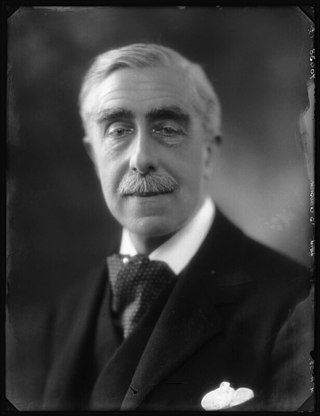
Sir Christopher WrenFRS was one of the most highly acclaimed English architects in history, as well as an anatomist, astronomer, geometer, and mathematician-physicist. Known for his work in the English Baroque style, he was accorded responsibility for rebuilding 52 churches in the City of London after the Great Fire in 1666, including what is regarded as his masterpiece, St Paul's Cathedral, on Ludgate Hill, completed in 1710.

The Zoological Society of London (ZSL) is a charity devoted to the worldwide conservation of animals and their habitats. It was founded in 1826. Since 1828, it has maintained the London Zoo, and since 1931 Whipsnade Park.

Charles Bathurst, 1st Viscount Bledisloe, was a British Conservative politician and colonial governor. He was Governor-General of New Zealand from 1930 to 1935.
Walter Plowright CMG FRS FRCVS was an English veterinary scientist who devoted his career to the eradication of the cattle plague rinderpest. Plowright received the 1999 World Food Prize for his development of tissue culture rinderpest vaccine (TCRV), the key element in the quest to eliminate rinderpest. Rinderpest became the first animal disease to be eliminated worldwide.

Stoneleigh is a small village in Warwickshire, England, on the River Sowe, situated 4.5 miles (7.25 km) south of Coventry and 5.5 miles (9 km) north of Leamington Spa. The population taken at the 2011 census was 3,636. The village is about 600 yards (549 m) northeast of the confluence of the River Sowe and the River Avon. The village's church is dedicated to the Virgin Mary. Stoneleigh has no public house: all three were closed by Lord Leigh more than 100 years ago, after his daughter was laughed at by drunks when she was going to church on a tricycle. However it has a social club, which meets in the evenings on Vicarage Road.

Thomas Andrew Knight (1759–1838), FRS, of Elton Hall in the parish of Elton in Herefordshire and later of Downton Castle, was a British horticulturalist and botanist. He served as the 2nd President of the Royal Horticultural Society (1811–1838).

Sir Edward Chandos Leigh was a British aristocrat of the Victorian era, a barrister by profession, and a first-class cricketer. He served as President of MCC for 1887–88.

The Royal Show, also known as the Royal Agricultural Show, was an annual agricultural show/fair held by the Royal Agricultural Society of England every year from 1839 to 2009. The event encompassed all aspects of farming, food and rural life - from the best of British livestock to the latest business and technological innovations in the farming industry. Over 1,000 stands, world-class livestock and equine classes attracted visitors from over 100 countries.

Stoneleigh Park, known between 1963 and 2013 as the National Agricultural Centre, is a business park located south-west of the village of Stoneleigh, Warwickshire, England. It is home to the NAEC Stoneleigh conference and exhibition centre.

Chandos Leigh, 1st Baron Leigh was a British landowner and minor poet. He was Lord of the Manor of Hunningham.

Little Leigh is a civil parish and village within the unitary authority of Cheshire West and Chester and the ceremonial county of Cheshire, England. It is situated on high ground on the north bank of the River Weaver; it is approximately 2 miles north of Weaverham on the A533 road and about three miles north-west of Northwich. The population of the civil parish taken at the 2011 census was 567.

Stoneleigh Abbey is an English country house and estate situated south of Coventry. Nearby is the village of Stoneleigh, Warwickshire. The Abbey itself is a Grade I listed building.
The Hoskyns Baronetcy, of Harewood in the County of Hereford, is a title in the Baronetage of England. It was created on 18 December 1676 for Bennet Hoskyns, Member of Parliament for Wendover, Hereford and Herefordshire. He was the son of the poet, lawyer and politician John Hoskins. The second Baronet was one of the founders of the Royal Society and served as its president from 1682 to 1683. The fourth Baronet fought under the Duke of Marlborough in the War of the Spanish Succession and also represented Herefordshire in the House of Commons. The twelfth Baronet was Lord Bishop of Southwell from 1904 to 1925.
Chandos Wren-Hoskyns BA, JP, DL was an English landowner, agriculturist, politician and author. Not all of his views are shared today.

Ralph Bathurst, FRS was an English theologian and physician.
Percival Stephen Cane (1881–1976) was an English garden designer and writer.
Beekeeping in the United Kingdom is the maintenance of bee colonies by humans within the United Kingdom. It is a significant commercial activity that provides those involved with honey, beeswax, royal jelly, queen bees, propolis, flower pollen and bee pollen. Honeybees also provide pollination services to orchards and a variety of seed crops.

Henry Corbet was an English agricultural writer, and editor of the weekly The Mark Lane Express Agricultural Journal for twenty years. Together with John Morton he is considered one of "the leading agricultural editors during the most prosperous period of Victorian 'high farming' of the 1850s and 1860s."

William Shaw"of the strand" (1797–1853) was a British agricultural writer, editor and translator, first editor of the agricultural journal Mark Lane Express, and of The Farmer's almanac and calendar, and co-founder of the Farmers Club in 1842. He is known for advocating agricultural reforms and improvements.

Alscot Park is an English Grade I listed Georgian country house in Preston on Stour, some 3 miles (5 km) south of Stratford-upon-Avon, Warwickshire. It was built in a Rococo Gothic style for James West in the early 18th century.















